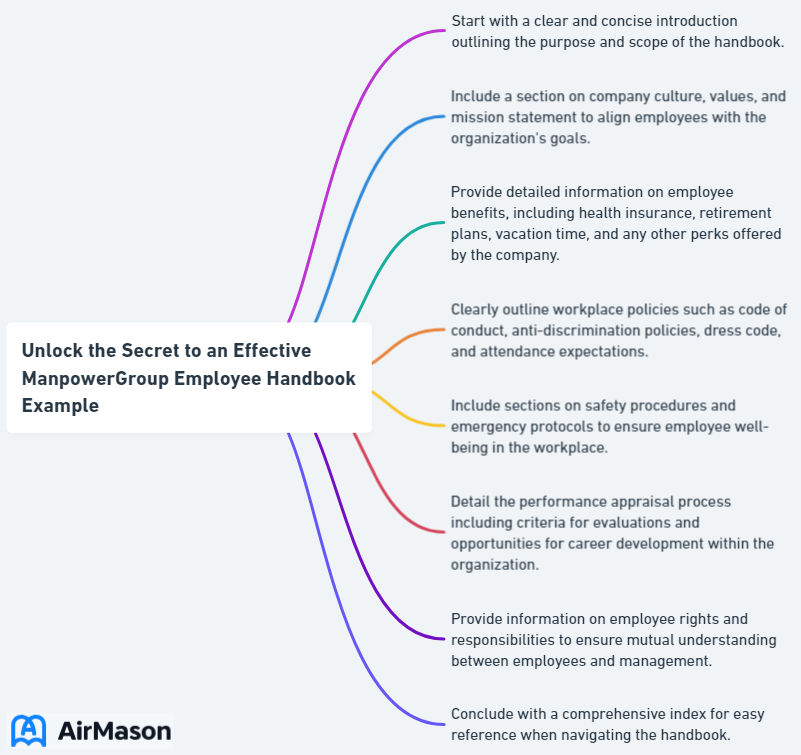
Are you ready to unlock the secret to crafting an effective ManpowerGroup Employee Handbook? Dive with us into the world of innovative workforce solutions and learn how to create a comprehensive guide that establishes clear expectations for your employees and helps your organization thrive in the future of work. Discover the power of a well-crafted “manpowergroup employee handbook example” and see how it can transform your business.
Key Takeaways
- ManpowerGroup Employee Handbook is a comprehensive guide to ensure equitable and sustainable employment opportunities.
- Employers should outline expectations for employees in the handbook, including key components such as organizational information, compensation and benefits, code of conduct etc.
- Regularly review and revise the handbook annually to keep it up-to-date with legal requirements & industry standards.
Fortune 100 Company Employee Handbook
Welcome to the comprehensive guide that governs our workplace environment – the Fortune 100 Company Employee Handbook. This essential document outlines the principles, policies, and expectations that shape our corporate culture. Within the pages of the Fortune 100 Company Employee Handbook, you’ll find a wealth of information designed to ensure a positive and productive experience for every member of our esteemed team. Familiarizing yourself with the content herein is crucial for understanding the values and standards that define our organization. As you embark on your journey with us, this handbook will serve as a valuable resource, providing guidance on everything from professional conduct to benefits and beyond.
The Essence of a ManpowerGroup Employee Handbook
The ManpowerGroup Employee Handbook serves as a comprehensive guide for employees, detailing company policies, procedures, and expectations tailored to ManpowerGroup’s innovative workforce solutions. As one of the world’s most ethical companies, ManpowerGroup is dedicated to providing meaningful and sustainable employment opportunities for millions of people across the globe.
The employee handbook promotes uniformity and equity in employee management, while also readying your workforce for future work scenarios.

The Role of Employee Handbooks in Innovative Workforce Solutions
Employee Handbooks are significant in forming a knowledgeable and productive workforce, as they furnish explicit instructions and regulations to employees on how to sustain a secure and wholesome work atmosphere. ManpowerGroup’s approach to health and safety in the workplace reflects the lessons learned from the COVID-19 pandemic, emphasizing the need for a comprehensive and unified vision of safety that encompasses the entire workforce and perpetual collaboration with partners.
The Employee Handbook contributes to a setting that supports innovative workforce solutions, through clear safety protocols, evaluation of relevant regulations, and consideration of health and safety policies. Thus, employees can focus on delivering their best work, knowing that the company has their well-being in mind.
Establishing Expectations for Employees
Establishing expectations for employees in an Employee Handbook is of great importance for several reasons, including clarity in communication, consistency in holding employees to the same criteria, legal compliance, performance management, and employee engagement. ManpowerGroup’s employee handbook outlines expectations such as prohibiting communication with governmental authorities unless in good faith and with a reasonable belief, adhering to strong values and business practices, and undertaking ethics training.
The repercussions of not meeting expectations can vary depending on the severity of the violation. Employers may issue verbal or written warnings, suspend or terminate employment, or take other disciplinary action. By establishing clear expectations in the Employee Handbook, organizations can ensure a productive and harmonious work environment where employees understand their roles and responsibilities.
Crafting Your Own ManpowerGroup Employee Handbook

Creating a customized ManpowerGroup Employee Handbook that aligns with your organization’s specific needs requires consideration of key components like:
- Expectations
- Compensation and benefits
- Conduct standards
- Non-discrimination policy
By carefully reviewing the existing handbook and tailoring policies and procedures to your organization’s unique requirements, you can craft a document that serves as a valuable resource for your employees and promotes a culture of compliance and understanding.
Key Components to Include
Creating your Employee Handbook necessitates inclusion of key components like:
- Organizational information
- Compensation and benefits
- Code of conduct
- Leave of absence policies
- Equal employment and non-discrimination policies
- An acknowledgment of receipt
Incorporating the company mission, values, and culture into the Employee Handbook helps employees understand the expectations and fosters a productive and unified work atmosphere.
Information on compensation and benefits should also be included in the Employee Handbook to ensure transparency and clarity regarding employee remuneration and the advantages they are eligible for. Providing comprehensive guidelines for the company code of conduct further promotes a professional work environment and adherence to company values.
Adapting to Your Organization’s Needs
Adapting an Employee Handbook to your organization’s needs requires the following steps:
- Analysis of the existing handbook
- Identification of organization-specific practices
- Content customization
- Establishment of clear guidelines
- Solicitation of input and feedback
- Regular updates to the handbook
By following these steps, your Employee Handbook will effectively cater to a diverse workforce, ensuring that all employees, regardless of their background, feel valued and included in the organization.
Harmonizing the Employee Handbook with your organization’s mission and values provides a clear sense of direction, facilitates decision-making, enhances employee engagement and productivity, and establishes loyalty within your workforce. By taking these factors into account, your customized Employee Handbook will serve as a valuable resource for your employees, ultimately contributing to the overall success of your organization.
ManpowerGroup Employee Handbook Example: A Step-by-Step Guide

While creating a ManpowerGroup Employee Handbook might appear challenging, adhering to a step-by-step guide ensures inclusion of all essential sections and content in your handbook. Start by designing an attractive cover page and a well-organized table of contents for easy navigation.
Then, outline company policies and procedures, and detail employee benefits and perks to attract and retain top talent.
Bank of New York Mellon Employee Handbook Example
In the Bank of New York Mellon employee handbook example, employees gain valuable insights into the company’s policies, culture, and expectations. The Bank of New York Mellon employee handbook example serves as a comprehensive guide, providing clear guidelines on professional conduct, benefits, and organizational values. Through this handbook, employees can navigate their roles with confidence, ensuring alignment with the Bank of New York Mellon’s mission and fostering a collaborative and supportive work environment. From onboarding to ongoing development, the Bank of New York Mellon employee handbook example plays a crucial role in shaping a positive and successful employee experience at the organization.
Cover Page and Table of Contents
An effective cover page should include the following elements:
- Company logo and name
- Title
- Version or edition number
- Effective date or revision date
- Table of contents
Utilize a professional and sophisticated design that is in accordance with your company’s branding to create a visually appealing cover page.
The table of contents should include elements such as basic employment information, employment policies, workplace code of conduct, company mission and vision, values, and general employment information. Additionally, it should encompass sections on attendance, employee protections, pay and progress, and on-the-job information.
Policies and Procedures
Outlining company policies and procedures in your Employee Handbook is crucial for ensuring a consistent and compliant work environment. Some essential policies and procedures to include in a ManpowerGroup Employee Handbook are:
- Code of Business Conduct and Ethics
- Communication Policy
- Anti-Harassment and Anti-Discrimination Policy
- Attendance and Punctuality Policy
- Leave and Time Off Policy
- Performance Management Policy
- Health and Safety Policy
- Confidentiality and Data Protection Policy
Incorporating these policies and procedures not only ensures compliance with employment laws and regulations but also contributes to ManpowerGroup’s reputation as one of the world’s most ethical companies. By providing clear guidelines for employee conduct and performance, your Employee Handbook will serve as a valuable resource for your workforce, reflecting the world’s most ethical standards.
Benefits and Perks
Detailing employee benefits and perks in your Employee Handbook is essential for attracting and retaining top talent. ManpowerGroup offers a variety of benefits, such as:
- Retirement plans
- Supplemental life insurance
- Short-term disability insurance
- Instant pay
- Referral rewards programs
- Access to the Global Learning Center, which offers over 1,800 business courses.
By outlining these benefits and perks in your Employee Handbook, you can ensure that employees are aware of the advantages provided by your organization and promote a culture of appreciation and loyalty. In turn, this can lead to increased employee satisfaction and productivity, ultimately contributing to the overall success of your company.
Ensuring Compliance and Understanding

Maintaining an effective work environment requires employee compliance and understanding of the Employee Handbook. Employers can achieve this by implementing the following strategies:
- Seek feedback from employees to ensure that the Employee Handbook is clear and comprehensive.
- Provide training and resources to help employees understand and follow company policies and procedures.
- Consistently enforce expectations outlined in the Employee Handbook to promote a culture of compliance.
By following these strategies, employers can guarantee that their workforce is well-informed and adheres to company policies and procedures.
The Significance of the Employee Handbook Agreement Form
The Employee Handbook Agreement Form is a valuable tool for confirming employee acknowledgment and compliance with the handbook’s content. By having employees sign the agreement form, employers create a definitive understanding between both parties and can potentially use the form as evidence that the employee was apprised of the company’s regulations.
The form is typically signed by the employee upon commencement of employment or when the handbook is revised. This practice not only ensures legal compliance but also promotes a culture of transparency and understanding within the organization.
Tips for Encouraging Employee Engagement
Promoting employee engagement with the Employee Handbook is essential for fostering a culture of compliance and understanding. Some strategies for encouraging engagement include:
- Seeking feedback from employees
- Being open and transparent about company goals and challenges
- Highlighting company culture
- Conducting employee surveys to assess the effectiveness of the handbook.
Gamification can also be employed to augment employee comprehension of the handbook, transforming the learning process into a game. Incorporating elements such as quizzes, challenges, and rewards can motivate employees to actively engage in the learning process and gain a more comprehensive understanding of the handbook content.
Updating Your Employee Handbook

Frequent updates to your Employee Handbook ensure it remains effective and relevant. By revising the handbook at least annually or when significant changes occur, you can guarantee that your document remains current and adheres to any alterations in employment regulations and industry benchmarks.
When to Update Your Handbook
It is essential to update your Employee Handbook when:
- There are changes in laws and regulations
- Company policy alterations
- Employee feedback
- The handbook does not accurately reflect how matters take place within the company
Neglecting to update the handbook can leave your organization vulnerable to accountability and legal disputes.
For sustained effectiveness of your Employee Handbook, it’s advisable to review and revise the document once every one to two years, preferably on an annual basis.
Best Practices for Updating Your Handbook
Following best practices for updating the document is important to ensure that your Employee Handbook continues to be a valuable resource. Here are some key steps to take:
- Incorporate feedback from key stakeholders.
- Ensure the handbook is in accordance with applicable laws and regulations.
- Guarantee that it is comprehensible and succinct.
- Make the handbook accessible to all employees.
By following these best practices, you can maintain an effective and up-to-date Employee Handbook.
By regularly inspecting and amending the Employee Handbook, you can ensure that your document stays current and continues to serve as an invaluable guide for your workforce. In turn, this can lead to increased employee satisfaction, productivity, and overall success for your organization.
Summary
In conclusion, crafting an effective ManpowerGroup Employee Handbook is an essential tool for ensuring a well-informed and productive workforce. By following the guidelines and best practices outlined in this blog post, you can create a comprehensive guide that establishes clear expectations for your employees, promotes a culture of compliance and understanding, and ultimately contributes to the overall success of your organization.
Frequently Asked Questions
What should be included in a employee handbook?
An employee handbook should include sections such as Welcome and New Hire Processes, Company Policies and Culture, Legal Requirements, Paid Time Off Policies, Benefits, Promotions and Compensation, Discipline and Termination Policies, Notice and Disclaimer/Acknowledgement of Receipt, Employment At-Will Policy, Equal Opportunity Statement and Anti-Harassment Statement, Work Authorization, Policy on Employment Classification, Overtime, Leaves of Absence, and Parental Leave.
What is the PTO policy for manpower group?
ManpowerGroup’s PTO and Vacation policy offers 15-20 days off a year with 0% work free while out of office, representing a cash value of over $2500 per month.
How do I create an employee handbook template?
To create an Employee Handbook template, start by including Company Values and Mission Statement, General Employment Information, Anti-Discrimination and Anti-Harassment Laws, Standards of Conduct, Employee Benefits, Confidentiality / Non-Disclosure Agreement / Conflict of Interest, Disciplinary Policies, and a Disclaimer.
How often should an Employee Handbook be updated?
Employee Handbooks should be reviewed and updated annually for best practice.
What strategies can be employed to encourage employee engagement with the Employee Handbook?
Encourage employee engagement with the Employee Handbook by seeking feedback, being transparent about company goals and challenges, highlighting company culture, and conducting surveys to assess its effectiveness.
Important Disclaimer:
The article presented here does not serve as a representation of the company’s actual employee handbook mentioned in this article.
Our discussions and insights regarding employee handbook are based on assumptions about what may be considered significant in this companies’ policies. These assumptions are drawn from available information and industry knowledge. Readers are advised that the content provided is for informational purposes only and should not be construed as an exact reflection of any company’s official policies or procedures. For precise and accurate details regarding a company’s employee handbook, individuals should refer directly to the company’s official documentation or consult with appropriate representatives.
Please be aware that the content on this page has been generated by using artificial intelligence language models and may contain errors, inconsistencies, or outdated information. It is provided as-is without any warranties or guarantees of accuracy. We strongly recommend using this content as a starting point for further research. We disclaim any liability for damages or losses resulting from the use or reliance on this content.